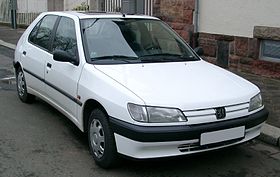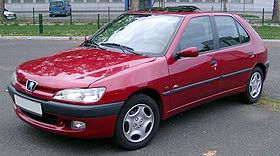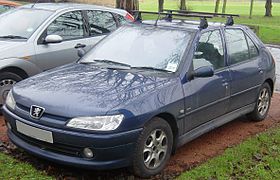Peugeot 306 Maxi
| Peugeot 306 | |
|---|---|
 |
|
| Overview | |
| Manufacturer | Peugeot |
| Production | 2.846 million units 1993–2002 |
| Assembly |
Poissy, France Ryton-on-Dunsmore, Great Britain El Palomar, Argentina (Sevel; Sedan) Los Andes, Chile Barra de Carrasco, Uruguay (Oferol; Break) |
| Designer | Pininfarina |
| Body and chassis | |
| Class | Small family car (C) |
| Body style | 3/5-door hatchback 4-door saloon 5-door estate 2-door cabriolet |
| Layout | FF layout |
| Related |
Citroën Xsara Citroën ZX |
| Powertrain | |
| Transmission | 4-speed automatic ZF 4HP14 4-speed automatic AL4 5-speed manual MA 5 5-speed manual BE 3/5 6-speed manual BE 3/6 |
| Dimensions | |
| Wheelbase | 2,580 mm (102 in) |
| Length | 4,030 mm (159 in) (hatchback) 4,267 mm (168 in) (sedan) 4,338 mm (171 in) (wagon) |
| Width | 1,680 mm (66 in) |
| Height | 1,380 mm (54 in) (hatchback) 1,386 mm (55 in) (sedan) 1,415 mm (56 in) (wagon) |
| Chronology | |
| Predecessor | Peugeot 309 |
| Successor | Peugeot 307 |
| Phase 1 | |
|---|---|
 |
|
| Overview | |
| Production | 1993–1997 |
| Powertrain | |
| Engine |
Petrol engines: |
| Phase 2 (N5) | |
|---|---|
 |
|
| Overview | |
| Production | 1997–1999 |
| Powertrain | |
| Engine |
Petrol engines: |
| Phase 3 | |
|---|---|
 |
|
| Overview | |
| Production | 1999–2002 |
| Powertrain | |
| Engine |
Petrol engines: |
The Peugeot 306 is a small family car built by the French car manufacturer Peugeot from 1993 to 2002. It replaced the 309. Peugeot gave the 306 many updates and aesthetic changes to keep up with the competition, and it was replaced by the 307 in 2001. Cabriolet and estate versions continued until 2002. Versions were built in Argentina by Sevel from 1996 to 2002.
The 306 was developed between 1990 and 1992 for a launch at the beginning of 1993. It was a replacement for the Peugeot 309 (which had broken with Peugeot's normal ascending numbering system partly due to it being released before the older and larger Peugeot 305 was axed).
Concept versions of the 306 were first seen around the end of 1990, although the motoring press initially reported that it was going to replace the smaller 205. However, by the end of 1991, Peugeot had confirmed that the new car was going to replace the 309, as well as some versions of the 205, which was going to remain in production for several more years, despite the launch of the entry-level 106 supermini in 1991.
Mechanically, the 306 is virtually identical to the Citroën ZX, which was launched two years before the 306: both cars use the same floorpan and core structure. The 306, with its attractive Peugeot 205 derived Pininfarina styling, was a more successful car than its twin. The Citroën Berlingo and Peugeot Partner were also built on the same platform. The chassis used by the 306 and ZX was also used in the ZX's replacement, the Citroën Xsara. The sharing of platforms between Peugeot and Citroën has been parent company PSA Peugeot Citroën policy since the late 1970s, after the Peugeot takeover of the then bankrupt Citroen in the wake of the 1974 oil crisis. The first car being the Peugeot 104 based Citroën Visa and Citroën LNA and Talbot Samba. The policy continues today throughout the Peugeot and Citroën ranges. The entry level Peugeot 108, Citroën C1 and Toyota Aygo though are all based on the same Toyota design, and not a PSA one.
...
Wikipedia
